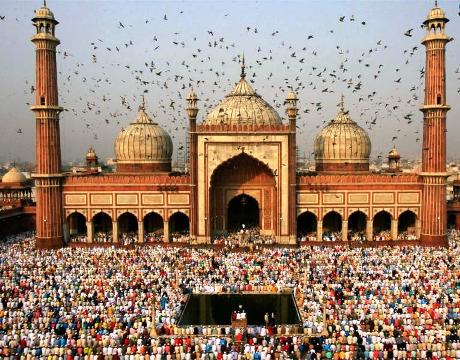SHAHJAHANI Mosque (Taj Mahal Mosque), Agra, U.P., India
Built by Mughal Emperor, Shahjahan, This is a great piece of
architecture. But unlike the previous Mughal Mosques architecture, this
mosque departs from the idea of "greatness does not necessarily lies in
grandness". A rather small on Mughal scale of mosques, This is
nonetheless an impressive architectural accomplishment and gives you
a single best view from inside looking out can be easily envied
by other great mosques of the world. . I hope you know what I am talking about.
Mughal Emperor Shah Jahan's grand mosque. Shah Jahan built many
mosques in Delhi but Jama Mosque turned out to be the Largest Mosque
built in India. Its a stunning peace of architecture and gives you a
breathtaking view of Old Delhi and its legendary Chandni Chowk (Moon
Lit Avenue) area. Boy!! did that Red Sandstone came in handy along with
Marble again...Vintage Jama Mosque Image..(1878)
Jama Mosque, Fatehpur Sikri, India.
Emperor Akbar's epic in Red sandstones and Marble.
Built during the Mughal Empire's Golden Era of Akbar's reign, this
mosque by many is considered the greatest accomplishment of emperor
Akbar who was known to be a pioneer in blending central Asian
architecture with regional Hindu architecture. Akbar's grand capital,
Fatehpur Sikri and Sikandra are prime examples.
Door of Knowledge
After the Great Uprising of 1857, there was perceptible change in
the thinking of the Muslims in India. The revolt against the British
imperialists was conducted under the banner of Bahadur Shah Zafar, who
was then an ailing Emperor of the fast disintegrating Mughal Empire
thanks to British tactics and previous emperor Aurangzeb's antics. It
was realised that feelings of national integration were of utmost
importance for the liberation of the country.















